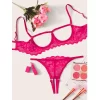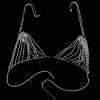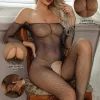We ship products to USA,Canada!
The Influence of Color Theory on Sexy Lingerie Design: How Colors Shape Sensuality and Confidence
Color theory plays a crucial role in the design of sexy lingerie, influencing both the aesthetics and the emotional response it evokes. Designers utilize color psychology to create pieces that not only flatter the wearer but also provoke certain feelings, emotions, and reactions. Understanding how different colors impact mood, perception, and attraction helps lingerie designers craft collections that appeal to diverse preferences and occasions.
1. The Psychological Impact of Colors in Lingerie Design
Color is a powerful visual element that can evoke specific emotions and set the tone for intimate experiences. In lingerie design, this becomes especially important, as the wearer’s emotional state and confidence are heavily influenced by the color of the garments they choose. Here’s how some popular colors influence both the wearer and the observer:
- Red: Often associated with passion, desire, and excitement, red is the most stimulating color in lingerie. It heightens physical attraction, drawing attention and stimulating a sense of urgency or lust. Designers use red to create bold, striking pieces meant to convey confidence and allure, perfect for intimate, high-energy settings.
- Black: Black is synonymous with mystery, sophistication, and power. It is a classic in lingerie design, offering timeless elegance while also projecting a sense of control and sensuality. Black can be versatile—used for everything from sleek, minimalist designs to intricate lacework—making it ideal for both subtle and bold expressions of sexuality.
- White: White evokes purity, innocence, and simplicity. Often used in bridal lingerie, it can create an ethereal, romantic atmosphere. White lingerie is designed to highlight a softer, more delicate side of sensuality, often appealing to individuals who prefer understated beauty and elegance.
- Pink: Pink strikes a balance between playful and romantic. Lighter shades of pink suggest sweetness and flirtation, while hot pink projects a more energetic, fun vibe. Designers choose pink to convey youthfulness and femininity, making it a popular choice for pieces intended to be both cute and sexy.
- Purple: Known for its association with luxury and mystique, purple lingerie adds an element of mystery and fantasy. Dark purple shades like plum or violet are sensual and opulent, while lighter lavender tones suggest romance and tenderness. Designers use purple to evoke a sense of exclusivity and deeper emotional connections.
- Blue: Blue, often associated with calm and trust, brings a unique perspective to lingerie design. It’s less about fiery passion and more about emotional intimacy. Soft blues offer a sense of serenity and tenderness, while darker navy tones project sophistication. Though not as commonly used in lingerie, blue’s calming effect can set the mood for intimate, more emotionally grounded experiences.
- Green: Green, symbolizing renewal and balance, is sometimes incorporated into lingerie design to evoke freshness and nature. Designers may use emerald or deep green to offer an unconventional but captivating choice that suggests harmony and elegance, providing a unique alternative to more common colors like red or black.
2. The Role of Color in Body Confidence and Personal Expression
Designers also consider how color affects the wearer’s self-perception. Certain colors may help accentuate body features, create contrast with skin tone, or express personality traits. Sexy lingerie often seeks to empower the wearer, and color choice plays a significant role in this empowerment.
- Skin Tone and Contrast: One of the primary factors that designers consider is how the color of the lingerie interacts with various skin tones. For example, darker colors like black, navy, and deep red tend to flatter a wide range of skin tones by providing striking contrast. On the other hand, pastels and lighter shades may enhance paler skin tones by offering a soft, understated look. Designers use color strategically to ensure that the lingerie highlights the wearer’s natural beauty, making them feel confident and sexy.
- Color and Mood Enhancement: Beyond aesthetics, color can significantly impact the wearer’s mood. Warm tones like red, orange, and pink are energizing, and they tend to boost confidence and enthusiasm. Cooler tones like blue and green evoke calmness, relaxation, and trust. Designers take these effects into account, creating collections that can suit different emotional states. For example, red may be the perfect choice for a bold, adventurous night, while soft pastels can set a romantic, calming mood.
- Personal Expression through Color: Sexy lingerie also serves as a form of personal expression, and color is an essential tool in helping the wearer showcase their personality. Bold, bright colors like electric pink, vibrant red, or deep purple suggest someone who is confident, daring, and playful. More neutral shades like beige, cream, or black may convey sophistication, mystery, or minimalism. Designers create color palettes that allow individuals to express themselves based on how they feel or the mood they want to set.
3. Cultural and Societal Influences on Lingerie Color Trends
Cultural perceptions of color also influence how lingerie is designed and marketed. Different regions of the world attach specific meanings to colors, which can shape how sexy lingerie is received and worn in different markets.
- Western Lingerie Markets: In Western cultures, black and red are dominant in lingerie collections, as they are closely tied to notions of seduction, mystery, and desire. White is often reserved for bridal collections, symbolizing purity and romance. However, as societal norms evolve, there is a growing acceptance of experimenting with bolder and more unusual colors like purple, teal, and even metallics.
- Eastern Lingerie Markets: In contrast, Asian markets might see more preference for soft, pastel tones such as pink, lavender, and peach, as these are linked to femininity and innocence. Red is particularly important in Chinese culture, symbolizing luck, happiness, and prosperity, making it a popular choice not only for sensuality but also for special occasions like weddings and holidays.
- Global Color Trends: Globalization has brought new trends in color choices, with designers increasingly drawing inspiration from diverse cultural influences. This has led to a broader palette being used in lingerie collections worldwide, allowing for more versatility and variety in color options. For instance, lingerie brands may combine traditional Western favorites like black with exotic patterns or textures from other cultures.
4. The Impact of Fashion Trends on Lingerie Color Design
Fashion trends significantly impact lingerie color choices, and designers often align their lingerie collections with broader seasonal trends. For example:
- Seasonal Collections: Lingerie collections often follow seasonal color trends, with darker, richer tones like burgundy, navy, and forest green appearing in fall and winter collections. In contrast, spring and summer lines tend to feature lighter, brighter colors like blush pink, coral, sky blue, and lemon yellow to reflect the freshness and vibrancy of the seasons.
- Sustainability and Natural Tones: With the increasing focus on sustainability in fashion, lingerie designers are also embracing earthy, natural tones such as beige, olive, and terracotta. These colors evoke a connection to nature and simplicity, resonating with consumers who seek eco-friendly and timeless lingerie options.
Conclusion: The Essential Role of Color in Lingerie Design
Color theory is at the heart of sexy lingerie design, influencing how pieces are crafted, perceived, and worn. Designers carefully select colors to evoke specific emotional responses, flatter diverse body types, and allow for personal expression. Whether it’s the sultry allure of black, the passionate fire of red, or the playful innocence of pink, each color offers a unique way to enhance sensuality and self-confidence.
As lingerie continues to evolve, color will remain a crucial tool for designers to innovate and respond to both fashion trends and the psychological impact of their creations, ensuring that lingerie not only looks beautiful but also feels empowering to wear.





